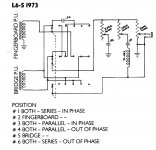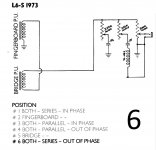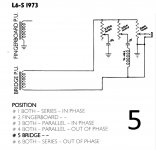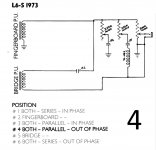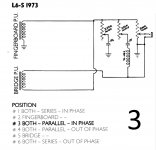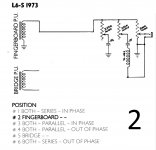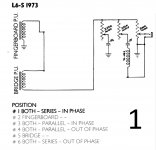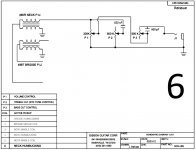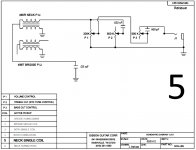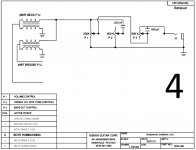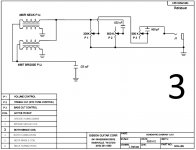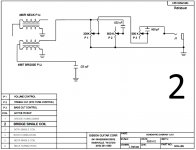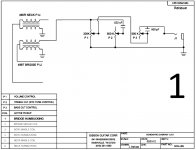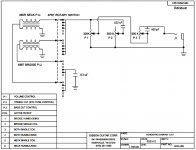Anyone know much about these solid-body guitars? They have a reputation for being versatile and able to cover a lot of basic sounds.
This series was designed by Bill Lawrence. I've seen schematics and wiring diagrams, and descriptions, on the 'net. They don't really quite agree. The schematics look like the pickups are always run as humbuckers, and the 6-position switch has (not in correct sequence) 1 'bucker, the other bucker, both parallel in-phase, both parallel out of phase, both series in-phase, both series out of phase. And from you-tube clips the out of phase settings do make the harmonics pop like two pickups out of phase. But current Gibson marketing lit says the 4-wire pickups have single-coil settings. Not according to he schematics which show one pickup as 2-wire and the other as 3. Unless they screwed up Bill Lawrence's original design in making the reissue.
There's also some capacitor across one pickup (the bass neck pickup I think) when both are on (series or parallel or both I can't remember). I can only imagine that the intent is to eliminate the way the inductance of the neck pickup can ruin the treble of the bridge pickup.
Also, there's a standard treble-cut that affects the total sound, then there's another tone control that affects the total sound and has a cap and an inductor. Gibson calls it a bass lowpass control, but everyone else calls it a mid-peak bandpass control.
I just bought a near-new reissue L6S on impulse in clear maple; just kind of reactionary to always wanting to try a maple-neck gibson. I wisk it was prettier maple, as this doesn't look like much more than pine, no burl or flame etc. I'm hoping it's been delivered by the time I get home, as I haven't seen it yet. If you really know this guitar's wiring, please share what you know as I'm going nuts with anticipation.
This series was designed by Bill Lawrence. I've seen schematics and wiring diagrams, and descriptions, on the 'net. They don't really quite agree. The schematics look like the pickups are always run as humbuckers, and the 6-position switch has (not in correct sequence) 1 'bucker, the other bucker, both parallel in-phase, both parallel out of phase, both series in-phase, both series out of phase. And from you-tube clips the out of phase settings do make the harmonics pop like two pickups out of phase. But current Gibson marketing lit says the 4-wire pickups have single-coil settings. Not according to he schematics which show one pickup as 2-wire and the other as 3. Unless they screwed up Bill Lawrence's original design in making the reissue.
There's also some capacitor across one pickup (the bass neck pickup I think) when both are on (series or parallel or both I can't remember). I can only imagine that the intent is to eliminate the way the inductance of the neck pickup can ruin the treble of the bridge pickup.
Also, there's a standard treble-cut that affects the total sound, then there's another tone control that affects the total sound and has a cap and an inductor. Gibson calls it a bass lowpass control, but everyone else calls it a mid-peak bandpass control.
I just bought a near-new reissue L6S on impulse in clear maple; just kind of reactionary to always wanting to try a maple-neck gibson. I wisk it was prettier maple, as this doesn't look like much more than pine, no burl or flame etc. I'm hoping it's been delivered by the time I get home, as I haven't seen it yet. If you really know this guitar's wiring, please share what you know as I'm going nuts with anticipation.
I'm really disappointed, or at least confused. The L6S was the only Gibson I knew of that had ALL the possible wiring combinations of two pickups on that 6-position switch. Now they won't supply a schematic of the wiring for whatever I bought in this 'reissue' L6S. It looks like they got rid of all the out of phase settings in favor of 2 single-coil settings.
There was something theoretically ideal about having ALL the possible single, series, parallel, and relative polarity (phase) settings available. If I wanted additional single-coil settings I would add micro-micro toggles to the pickup mounting rings.
Gibson won't supply a schematic or a wiring diagram for current models. Not even instructions for customers. I'm going to have to take it apart and draw out what the heck they're doing now. I sure wish they'd just stuck to what Bill Lawrence had, what Santana called 'his rainbow' of various sounds. It was probably the first guitar to have standard out of phase settings with both pickups on, and the first to have the choice of pickups in parallel or series. It's a big part of how Santana got so expressive. Now some buffon at Gibson decides that the out of phase sounds are thin... He just doesn't understand the unique special things that they do!
I sure hope this guitar still uses a standard 3-gang rotary switch and I'll just rewire it to the original way Bill Lawrence and God (same) intended. Then I can add switches to each pickup for making the individual coils series or parallel or single-coil.
Truth is that I don't like rotary selectors at all anyway. So I might just get rid of it. Bill Lawrence seems to have resorted to one because mfgrs hate switches that sometimes do nothing. For instance, I think the Jaguar had pre-set knobs and they were not popular. A phase switch only does something when both pickups are on. Same with a series/parallel switch.
Perhaps this is an opportunity for me to work up an alternate pickguard with switches instead. I never did like the rotary, and it's really hard to tell what is selected while in-use.
I do like the 3 pots: volume, standard treble-cut, and a unique "mid" control that had a cap and inductor in series. I sure hope Gibson didn't screw up that in the re-issue also.
There was something theoretically ideal about having ALL the possible single, series, parallel, and relative polarity (phase) settings available. If I wanted additional single-coil settings I would add micro-micro toggles to the pickup mounting rings.
Gibson won't supply a schematic or a wiring diagram for current models. Not even instructions for customers. I'm going to have to take it apart and draw out what the heck they're doing now. I sure wish they'd just stuck to what Bill Lawrence had, what Santana called 'his rainbow' of various sounds. It was probably the first guitar to have standard out of phase settings with both pickups on, and the first to have the choice of pickups in parallel or series. It's a big part of how Santana got so expressive. Now some buffon at Gibson decides that the out of phase sounds are thin... He just doesn't understand the unique special things that they do!
I sure hope this guitar still uses a standard 3-gang rotary switch and I'll just rewire it to the original way Bill Lawrence and God (same) intended. Then I can add switches to each pickup for making the individual coils series or parallel or single-coil.
Truth is that I don't like rotary selectors at all anyway. So I might just get rid of it. Bill Lawrence seems to have resorted to one because mfgrs hate switches that sometimes do nothing. For instance, I think the Jaguar had pre-set knobs and they were not popular. A phase switch only does something when both pickups are on. Same with a series/parallel switch.
Perhaps this is an opportunity for me to work up an alternate pickguard with switches instead. I never did like the rotary, and it's really hard to tell what is selected while in-use.
I do like the 3 pots: volume, standard treble-cut, and a unique "mid" control that had a cap and inductor in series. I sure hope Gibson didn't screw up that in the re-issue also.
Last edited:
Loudthud,
Yes, that's the original. It allows all 6 possible ways of wiring 2 pickups. Once upon a time software companies supplied source code, and electronic equipment mfgrs supplied schematics. Gibson doesn't release schematics for new guitars, according to the main customer support hotline.
Harleyjon,
There are still good things about it. I much prefer a maple neck over mahogany, and I even like a maple fingerboard. I like a single-cutaway. The body is not too thick and not too thin, and lays agianst your body well. I like the pickups. I like the Grover machine heads. the tuneomatic is acceptable. I really like the one volume and the 2 tone controls including the low-mid control. I just don't understand why they made a re-issue and screwed with the wiring. What were they thinking?
Yes, that's the original. It allows all 6 possible ways of wiring 2 pickups. Once upon a time software companies supplied source code, and electronic equipment mfgrs supplied schematics. Gibson doesn't release schematics for new guitars, according to the main customer support hotline.
Harleyjon,
There are still good things about it. I much prefer a maple neck over mahogany, and I even like a maple fingerboard. I like a single-cutaway. The body is not too thick and not too thin, and lays agianst your body well. I like the pickups. I like the Grover machine heads. the tuneomatic is acceptable. I really like the one volume and the 2 tone controls including the low-mid control. I just don't understand why they made a re-issue and screwed with the wiring. What were they thinking?
A really stable all-maple Gibson is still very cool w/ me. I don't need an arched top or fancy binding or fancy inlays.
I'll say one thing. This came from the factory already setup very nearly perfectly. I believe it was done on a Plek machine. The intonation was perfect, all frets perfect, nut perfect, bridge perfect. It usually takes a few days of screwing around with adjustments to get a new guitar optimized, but this made in the USA Gibson arrived as perfect as my Travis Beans. The Travis is perfect because there's no fingerboard radius and the neck is aluminum so the frets are surfaced perfect and the neck stays perfect until frets wear, and there's a zero fret at the nut so the nut just positions the strings and doesn't deterine their height. The L6-S is different; somebody just took the time to set it up, and I guess the Plek machine does it faster. I was skeptical, but now I'm convinced; it's another instance where automation equals consistency.
If you haven't checked out the Plek machine, you should.
If you haven't checked out the Plek machine, you should.
Last edited:
I bought one of these back in the 70's and sold it about 10 years later. I liked the fact that it was an all-maple Gibson, had jumbo frets on a maple fretboard, and had very flexible switching with a wide variety of tones.
The big reason for buying it though was the short string length - shorter even than the normal Gibson scale. It let me play things I couldn't play on the longer scale instruments.
In the end I just couldn't deal with the ceramic magnet based pickups. They had too much harsh screechiness in their tone (now that there's a seriously technical comment - lol).
But quite honestly, I do wish now that I had kept it. It is a unique and useful instrument - and that's hard to say about a lot of other and more popular guitars.
Graeme
The big reason for buying it though was the short string length - shorter even than the normal Gibson scale. It let me play things I couldn't play on the longer scale instruments.
In the end I just couldn't deal with the ceramic magnet based pickups. They had too much harsh screechiness in their tone (now that there's a seriously technical comment - lol).
But quite honestly, I do wish now that I had kept it. It is a unique and useful instrument - and that's hard to say about a lot of other and more popular guitars.
Graeme
i'm surprised you didn't like the pickups, designed (like the guitar) buy bill Lawrence, and considered the first high-output yet low-inductgance pickups with reasonable highs from Gibson.
I finally got a schematic for the new one from Gibson. I definitely would prefer the original Bill Lawrence 'mid' tone control with an inductor and ALL the pickup wirings. I need the out of phase settings. The new controls are more "pleasant" but have a lot less variety.
I plan to re-wire it completely. I'll probably eliminate the rotary selector entirely, but keep all its functions.
I finally got a schematic for the new one from Gibson. I definitely would prefer the original Bill Lawrence 'mid' tone control with an inductor and ALL the pickup wirings. I need the out of phase settings. The new controls are more "pleasant" but have a lot less variety.
I plan to re-wire it completely. I'll probably eliminate the rotary selector entirely, but keep all its functions.
Well, in the years since I posted this its definitely grown on me. It comes with 490T/498R humbuckers now, with seperate wires for each coil. The new single-coil sounds are very useful; the two humbucking coils which constitute one pickup are normally wired in series, so normally in single-coil mode you would just short one coil; but instead Gibson now puts a cap across one to turn it "off"! That means that for the treble and mids it behaves like a single-coil, but for the lower frequencies (and 60 hz) it's still a humbucker. It's a really nice trick I'd heard of before but never from a major mfgr. A lot of people didn't ever like the wide "harmonica" bridge (from Schaller) on the original, so the re-issue has Gibson's ABR1 tune-o-matic on their Nashiville studs. So I got a drop-in aftermarket upgrade Callaham ABR1 bridge for it, which is basically a tune-o-matic that's precision machined from billet hard stainless steel then tempered, instead of die-cast zinc, and their stainless & plated stop bar too. New Cobalt strings really brought out the bas and treble too, must more output. So...the new sounds from the 6-position selector are all good and sounding more distinct from each other now.
But...the 6-position switch has several drawbacks in actual use. You can't see it down at the bottom of the guitar, and it's nearly impossible to tell where it's pointing from any tactile feedback trying to feel up the chicken-head knob and then trying to feel the milled-out number it points at...pretty unworkable on-stage mid-song. Plus, it has to go thru the other positions to get where you want, which might be awful while playing. It's a lot more difficult to whack than a big toggle.
This multi-layer wafer rotary switch has more layers than the original, so it's getting pretty big; but I was considering trying to find a replacement with more layers, and wiring some very small SMD LEDs peeking out thru pinholes in the pickup rings. One light for each coil (four total) would indicate which coils were active, which would at least tell you which configuration you were on and let you know when you achieved the configuration you were looking for. Unfortunately, that really requires 4 more layers to the switch (which doubles how thick it is) and I hate needing a battery in your guitar (though of course the guitar still functions if the LED indicator battery dies). The use of LEDs in guitars also seems to date the guitar IMHO; at least these would be visible only to the player. I think that indicating which pickup coils are active is more directly useful data than just lighting up the number of LEDs that correspond to the switch position.
Another alternative would be to relocate the rotary switch to a position where the toggle is on many single-cutaway guitars (with the switch where the upper cutaway would have been). It's far enough out of the way, yet possibly easier to see, just easy to reach. Then some kind of tactile bump could indicate at least some reference position, like some keyboards have bumps or dents on the "home" keys.
Then it still needs a phase switch for more of those weird sounds the original had. Normally that's just a common 2 pole 2 throw. But...this has the tapped coils. So I'd have to think about what kind of switch could accomplish that.
Then it still doesn't have one of the old switch positions, which is when both pickups are in series with each other instead of in parallel with each other.
But...the 6-position switch has several drawbacks in actual use. You can't see it down at the bottom of the guitar, and it's nearly impossible to tell where it's pointing from any tactile feedback trying to feel up the chicken-head knob and then trying to feel the milled-out number it points at...pretty unworkable on-stage mid-song. Plus, it has to go thru the other positions to get where you want, which might be awful while playing. It's a lot more difficult to whack than a big toggle.
This multi-layer wafer rotary switch has more layers than the original, so it's getting pretty big; but I was considering trying to find a replacement with more layers, and wiring some very small SMD LEDs peeking out thru pinholes in the pickup rings. One light for each coil (four total) would indicate which coils were active, which would at least tell you which configuration you were on and let you know when you achieved the configuration you were looking for. Unfortunately, that really requires 4 more layers to the switch (which doubles how thick it is) and I hate needing a battery in your guitar (though of course the guitar still functions if the LED indicator battery dies). The use of LEDs in guitars also seems to date the guitar IMHO; at least these would be visible only to the player. I think that indicating which pickup coils are active is more directly useful data than just lighting up the number of LEDs that correspond to the switch position.
Another alternative would be to relocate the rotary switch to a position where the toggle is on many single-cutaway guitars (with the switch where the upper cutaway would have been). It's far enough out of the way, yet possibly easier to see, just easy to reach. Then some kind of tactile bump could indicate at least some reference position, like some keyboards have bumps or dents on the "home" keys.
Then it still needs a phase switch for more of those weird sounds the original had. Normally that's just a common 2 pole 2 throw. But...this has the tapped coils. So I'd have to think about what kind of switch could accomplish that.
Then it still doesn't have one of the old switch positions, which is when both pickups are in series with each other instead of in parallel with each other.
Last edited:
The Calaham billet stainless ABR-1 bridge is not exactly drop-in for a newer guitar with the Gibson Nashville bridge. Rather than install new posts I just reamed the post holes in the Calaham so it would work with the original Gibson Nashville posts. They are a bit loose just because they are cheap factory parts. So I am looking for some waxed thread to hold the bridge a bit more stable, just so that intonation remains perfect.
Last edited:
I've seen studio musicians stick pieces of sponge under the strings on the head and between the bridge and stopbar to eliminate any sympathetic vibration noises and dampen any sound if the strings are bumped. IMHO this is a really good idea.
Has anyone tried the Free-way Switch or Free-way Ultra 6-position toggle switch from NSF Controls? I'm curious how the "shift pattern" actually operates. It's two rows of 3 positions. I assume you can go directly from any position to any other; that the toggle bat feels like a 3-position switch horizontally and like a 2-position switch vertically. IMHO that would have MUCH better tactile feedback than the stupid stock rotary switch.
It is a toggle switch with 6 positions: an upper row of three and a lower row of three. I haven't tried one, but it seems just about perfect for what I want. It is not very deep, so it's easy to mount in even a thin-body guitar like an SG. It has some rather complicated combinations of make-before-break versus break-before-make for specific uses.
The wiring examples show that it can be wired to do all the same 6 rotary positions of the original L6-S. The lower row would act like the normal Les Paul or SG switch: bridge, both in parallel, neck. The upper row would have the weird original L6-S configurations: both in series, both in series out of phase, both in parallel out of phase.
It can probably also be wired to do all the same 6 rotary positions of my reissue L6S, with the single-coil positions instead of the series or out of phase ones.
But...it is as convenient as the other L6-S guitars that had a toggle, or a Les Paul.
So, my plan is to rout a new cavity in the backside just like a Les Paul toggle, since both the Les Paul and the L6S are single-cutaway and can have the switch, convenient and visible, instead of a pointless second cutaway (unless you're a lefty). That Free-way ultra will be wired to provide all the settings of the original L6-S and God and Bill Lawrence originally intended. Then all it's missing is the single-coil settings. Those could be most easily implemented as a DPDT push-pull switch on one of the pots, that would short out one winding on each pickup; since the two coils are in series that would just turn one off. Well, not quite "short out"...like Gibson did for the re-issue I would switch a carefully chosen capacitor across, so the treble & midrange is shorted out making it sound like a single-coil, but the bass and 60 HZ is still using both coiils, so it still bucks hum and has better low bass than a real single-coil.
Alternatively, you could have even more flexibility by having a three-position center-off single pole toggle switch for each pickup, so that you can select WHICH coil you are using in single-coil mode. I don't imagine they sound very different when mounted so near each other, but the exact choice of exactly which single coils are used together when two pickups are used will, when both bridge and neck pickups are on, affect whether the two single coils (one in each pickup) will buck hum together. The valid choices of coils for absolute minimum hum are different when the Free-way has the pickups "in phase" versus "out of phase". The independent singel-coil switches for each pickup also lets you use one pickup as a humbucker and the other as single-coil.
Then of course I need to make a new pickguard without the hole for the old rotary.
It is a toggle switch with 6 positions: an upper row of three and a lower row of three. I haven't tried one, but it seems just about perfect for what I want. It is not very deep, so it's easy to mount in even a thin-body guitar like an SG. It has some rather complicated combinations of make-before-break versus break-before-make for specific uses.
The wiring examples show that it can be wired to do all the same 6 rotary positions of the original L6-S. The lower row would act like the normal Les Paul or SG switch: bridge, both in parallel, neck. The upper row would have the weird original L6-S configurations: both in series, both in series out of phase, both in parallel out of phase.
It can probably also be wired to do all the same 6 rotary positions of my reissue L6S, with the single-coil positions instead of the series or out of phase ones.
But...it is as convenient as the other L6-S guitars that had a toggle, or a Les Paul.
So, my plan is to rout a new cavity in the backside just like a Les Paul toggle, since both the Les Paul and the L6S are single-cutaway and can have the switch, convenient and visible, instead of a pointless second cutaway (unless you're a lefty). That Free-way ultra will be wired to provide all the settings of the original L6-S and God and Bill Lawrence originally intended. Then all it's missing is the single-coil settings. Those could be most easily implemented as a DPDT push-pull switch on one of the pots, that would short out one winding on each pickup; since the two coils are in series that would just turn one off. Well, not quite "short out"...like Gibson did for the re-issue I would switch a carefully chosen capacitor across, so the treble & midrange is shorted out making it sound like a single-coil, but the bass and 60 HZ is still using both coiils, so it still bucks hum and has better low bass than a real single-coil.
Alternatively, you could have even more flexibility by having a three-position center-off single pole toggle switch for each pickup, so that you can select WHICH coil you are using in single-coil mode. I don't imagine they sound very different when mounted so near each other, but the exact choice of exactly which single coils are used together when two pickups are used will, when both bridge and neck pickups are on, affect whether the two single coils (one in each pickup) will buck hum together. The valid choices of coils for absolute minimum hum are different when the Free-way has the pickups "in phase" versus "out of phase". The independent singel-coil switches for each pickup also lets you use one pickup as a humbucker and the other as single-coil.
Then of course I need to make a new pickguard without the hole for the old rotary.
Last edited:
Well, in the years since I posted this its definitely grown on me. It comes with 490T/498R humbuckers now, with seperate wires for each coil. The new single-coil sounds are very useful;
Then it still doesn't have one of the old switch positions, which is when both pickups are in series with each other instead of in parallel with each other.
Hi Cyclecamper,
I still have two "original" L-6Ss, bought new - a Custom and a Deluxe. I don't think I can provide much additional insight over what you already have in terms of original vs. reissue Custom wiring. I can tell you that both of mine were rebuilt in 1979 with DiMarzio DP100s. Each DP100 has an added mini in/out phase switch, but these switches are for each individual pickup's twin coils. Back when the factory pickups were replaced, the phase switchable DiMarzios "sounded" like a huge upgrade. They have always been GREAT instruments used to produce unique harmonics.
Has anyone tried the Free-way Switch or Free-way Ultra 6-position toggle switch from NSF Controls? . . .
The lower row would act like the normal Les Paul or SG switch: bridge, both in parallel, neck. The upper row would have the weird original L6-S configurations: both in series, both in series out of phase, both in parallel out of phase. . .
But...it is as convenient as the other L6-S guitars that had a toggle, or a Les Paul. . .
Hi Cyclecamper, Have you made progress with the Free-Way?
Following your post, I have spent some time thinking about these NSF switches. Neither my 75 Deluxe, nor my 77 Custom have been "original equipment" since their DiMarzios were fired up in 1979. Therefore, I see no reason not to add a Free-Way. My Custom will be the first to undergo a "2015 refresh experiment" because the factory 6-way rotary sw has always been a notable weak link with this instrument.
I have no doubt that if the Free-Way SW had existed in 1979, it would have replaced the factory 6-way knob at the same time the pickups were "upgraded." (Today, if asked "why would anyone have taken the original Gibson pickups out," my attitude tends to be "if you are asking the question, you won't understand my answer . . .")
It seems to make the most sense to purchase the Free-Way Ultra, the NSF sw variant that should allow both wiring options to be evaluated: 1) The setup that matches the 1977 factory rotary circuit; and 2) The Reissue circuit to compare desirability of sounds produced with Gibson's newer wiring that, as you documented, came from Gibson with your Reissue L6-S Custom.
My guess is neither setup is likely to be an obvious "loser," so an additional mini-toggle may be involved to create a Mode Selection between the 1977 and the Reissue 6-way sw circuits . . . ?
Can you confirm the attached circuit diagram is correct as what you understand was the "vintage?"
My original diagram drawn out in '79 is long lost. You also indicated the factory was not at all inclined to provide you with their reissue circuit, so I am wondering if you are inclined to share a copy of what you eventually received from them?
If successful as expected on the Custom, I plan to follow up on my Deluxe.
Attachments
Last edited:
The wiring examples show that it can be wired to do all the same 6 rotary positions of the original L6-S.
It can probably also be wired to do all the same 6 rotary positions of my reissue L6S, with the single-coil positions instead of the series or out of phase ones.
Hi Cyclecamper,
To prep for wiring my first Free-Way Ultra, the 6 attached "diagrams" have been "extracted" from the vintage 6-way switch wiring diagram - simplified to show just the 6 positional circuits.
Attachments
It can probably also be wired to do all the same 6 rotary positions of my reissue L6S, with the single-coil positions instead of the series or out of phase ones.
Hi Cyclecamper,
I found the other thread where you posted the Reissue PDF you received from Gibson with their permission. THANKS! Added here are extracted diagrams for each of the 6 positions of the reissue 6-way switch. I think I agree the most sensible way to have it all is wire the Free-Way Ultra to present the Vintage 6 wirings, and add micro switches for the single coil options to add the 3 new Reissue wirings covering all old and new.
Attachments
I was very interested in these L6S's when I read about them in the '70's. But it seemed like all sounds were based on combining humbuckers, so no really edgy single-coil tones. But that is now addressed with the recent version.
I have a guitar in which I put some rotaries, and they can do a lot but they are too stiff and fiddly to use mid song. I think the best 'performance' switch for a rythym/solo change is a standard Gibson-style toggle.
So I'd be inclined to add one of those, probably rather than a Free-way. The rotary would be used to give 6 preset guitars, which you then control with the toggle, eg, HH, HS, SS, H-H etc, whatever you want.
Then, one pot becomes a push/pull to overide the toggle and put both pickups in series, as set by the rotary.
I think that would be very versatile, but also a simple player. If I had that, Id spend most time set with bridge humbucker and neck single on the rotary, then flicking the toggle only.
I have a guitar in which I put some rotaries, and they can do a lot but they are too stiff and fiddly to use mid song. I think the best 'performance' switch for a rythym/solo change is a standard Gibson-style toggle.
So I'd be inclined to add one of those, probably rather than a Free-way. The rotary would be used to give 6 preset guitars, which you then control with the toggle, eg, HH, HS, SS, H-H etc, whatever you want.
Then, one pot becomes a push/pull to overide the toggle and put both pickups in series, as set by the rotary.
I think that would be very versatile, but also a simple player. If I had that, Id spend most time set with bridge humbucker and neck single on the rotary, then flicking the toggle only.
- Status
- Not open for further replies.
- Home
- Live Sound
- Instruments and Amps
- Gibson L6S guitar wiring

